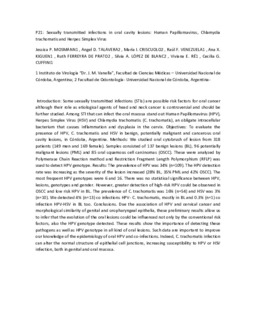| dc.contributor.author | Mosmann, Jessica Paola | |
| dc.contributor.author | Talavera, Angel Daniel | |
| dc.contributor.author | Criscuolo, María Inés | |
| dc.contributor.author | Venezuela, Raul Fernando | |
| dc.contributor.author | Kiguen, Ana Ximena | |
| dc.contributor.author | Ferreyra de Prato, Ruth | |
| dc.contributor.author | López de Blanc, Silvia | |
| dc.contributor.author | Ré, Viviana Elisabeth | |
| dc.contributor.author | Cuffini, Cecilia Gabriela | |
| dc.date.accessioned | 2022-05-06T13:45:21Z | |
| dc.date.available | 2022-05-06T13:45:21Z | |
| dc.date.issued | 2018 | |
| dc.identifier.uri | http://hdl.handle.net/11086/24665 | |
| dc.description.abstract | Introduction: Some sexually transmitted infections (STIs) are possible risk factors for oral cancer although their role as etiological agents of head and neck cancer is controversial and should be further studied. Among STI that can infect the oral mucosa stand out Human Papillomavirus (HPV), Herpes Simplex Virus (HSV) and Chlamydia trachomatis (C. trachomatis), an obligate intracellular bacterium that causes inflammation and dysplasia in the cervix. Objectives: To evaluate the presence of HPV, C. trachomatis and HSV in benign, potentially malignant and cancerous oral cavity lesions, in Córdoba, Argentina. Methods: We studied oral cytobrush of lesion from 318 patients (149 men and 169 female). Samples consisted of 137 benign lesions (BL), 96 potentially malignant lesions (PML) and 85 oral squamous cell carcinomas (OSCC). These were analyzed by Polymerase Chain Reaction method and Restriction Fragment Length Polymorphism (RFLP) was used to detect HPV genotype. Results: The prevalence of HPV was 34% (n=109). The HPV detection rate was increasing as the severity of the lesion increased (28% BL, 35% PML and 42% OSCC). The most frequent HPV genotypes were 6 and 16. There was no statistical significance between HPV, lesions, genotypes and gender. However, greater detection of high-risk HPV could be observed in OSCC and low risk HPV in BL. The prevalence of C. trachomatis was 16% (n=54) and HSV was 3% (n=10). We detected 4% (n=13) co infections HPV- C. trachomatis, mostly in BL and 0.3% (n=1) co infection HPV-HSV in BL too. Conclusions. Due the association of HPV and cervical cancer and morphological similarity of genital and oropharyngeal epithelia, these preliminary results allow us to infer that the evolution of the oral lesions could be influenced not only by the conventional risk factors, also the HPV genotype detected. These results show the importance of detecting these pathogens as well as HPV genotype in all kind of oral lesions. Such data are important to improve our knowledge of the epidemiology of oral HPV and co-infections. Indeed, C. trachomatis infection can alter the normal structure of epithelial cell junctions, increasing susceptibility to HPV or HSV infection, both in genital and oral mucosa. | es |
| dc.format.medium | Impreso | |
| dc.language.iso | eng | es |
| dc.rights | Attribution-NonCommercial-ShareAlike 4.0 International | * |
| dc.rights.uri | https://creativecommons.org/licenses/by-nc-sa/4.0/ | * |
| dc.subject | Sexually transmitted diseases | es |
| dc.subject | Enfermedades de transmisión sexual | es |
| dc.subject | Cavidad bucal | es |
| dc.subject | Oral cavity | es |
| dc.subject | Virus del papiloma humano VPH | es |
| dc.subject | Alphapapillomavirus | es |
| dc.title | Human Papillomavirus, Chlamydia trachomatis and Herpes Simplex Virus | es |
| dc.type | conferenceObject | es |
| dc.description.fil | Fil: Mosmann, Jessica Paola. Universidad Nacional de Córdoba. Facultad de Ciencias Médicas; Argentina. | es |
| dc.description.fil | Fil: Mosmann, Jessica Paola. Consejo Nacional de Investigaciones Científicas y Técnicas. Instituto de Virología Dr. José María Vanella; Argentina | es |
| dc.description.fil | Fil: Talavera, Angel Daniel. Universidad Nacional de Córdoba. Facultad de Odontología. Cátedra de Estomatología A; Argentina. | es |
| dc.description.fil | Fil: Criscuolo, María Inés. Universidad Nacional de Córdoba. Facultad de Odontología. Cátedra de Estomatología B; Argentina. | es |
| dc.description.fil | Fil: Venezuela, Raul Fernando. Universidad Nacional de Córdoba. Facultad de Ciencias Médicas; Argentina. | es |
| dc.description.fil | Fil: Kiguen, Ana Ximena. Universidad Nacional de Córdoba. Facultad de Ciencias Médicas; Argentina. | es |
| dc.description.fil | Fil: Ferreyra de Prato, Ruth. Universidad Nacional de Córdoba. Facultad de Odontología. Cátedra de Anatomía Patológica A; Argentina. | es |
| dc.description.fil | Fil: López de Blanc, Silvia. Universidad Nacional de Córdoba. Facultad de Odontología. Cátedra de Estomatología B; Argentina. | es |
| dc.description.fil | Fil: Ré, Viviana Elisabeth. Universidad Nacional de Córdoba. Facultad de Ciencias Médicas; Argentina. | es |
| dc.description.fil | Fil: Ré, Viviana Elisabeth. Consejo Nacional de Investigaciones Científicas y Técnicas. Instituto de Virología Dr. José María Vanella; Argentina | es |
| dc.description.fil | Fil: Cuffini, Cecilia Gabriela . Universidad Nacional de Córdoba. Facultad de Ciencias Médicas; Argentina. | es |
| dc.description.fil | Fil: Cuffini, Cecilia Gabriela . Consejo Nacional de Investigaciones Científicas y Técnicas. Instituto de Virología Dr. José María Vanella; Argentina. | es |
| dc.description.field | Otras Ciencias de la Salud | |
| dc.conference.city | Manduria | |
| dc.conference.country | Italia | |
| dc.conference.editorial | International Agency for Research on Cáncer | |
| dc.conference.event | 5th Meeting on Emerging Issues in Oncogenic Virus Research | |
| dc.conference.eventcountry | Italia | |
| dc.conference.eventdate | 2018-6 | |
| dc.conference.journal | Abstract book | |
| dc.conference.publication | Revista | |
| dc.conference.work | Resumen | |
| dc.conference.type | Congreso | |





